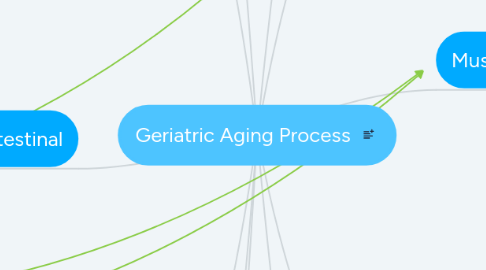
1. Nervous
1.1. Effects of Aging
1.1.1. loss of nerve cell mass
1.1.1.1. brain weight decreases
1.1.2. number of dendrites decline
1.1.3. demyelinization
1.1.3.1. response/reaction times slower
1.1.3.1.1. balance issues
1.1.3.2. reflexes become weaker
1.1.4. decrease in cerebral blood flow
1.1.4.1. severe decrease in cerebral blood flow
1.1.4.1.1. vascular dementia
1.1.5. plaques, tangles, atrophy of the brain
1.1.6. slowing in central processing
1.1.6.1. delay in time required to perform tasks
1.1.7. number and sensitivity of sensory receptors decrease
1.1.7.1. decrease in tactile sensation
1.1.7.1.1. increased risk for burns
1.1.8. decline in cranial nerve function
1.1.8.1. decreased taste and smell
2. Elimination
2.1. Effects of Aging
2.1.1. hypertrophy of the bladder muscle
2.1.1.1. decreases ability to expand
2.1.1.2. reduces storage capacity
2.1.1.2.1. daytime urinary frequency
2.1.1.2.2. nocturia
2.1.2. kidney filtration decreases
2.1.2.1. decreased ability to eliminate drugs
2.1.2.1.1. increased BUN levels
2.1.2.1.2. adverse drug reactions
2.1.3. weaker bladder muscle
2.1.3.1. stress incontinence
2.1.4. inefficient neurological control over bladder muscle
2.1.4.1. increased risk for incontinenece
2.1.4.1.1. bed sores
2.1.4.2. urinary retention
2.1.4.2.1. females
2.1.4.2.2. males
2.1.5. increase renal threshold for glucose
2.1.5.1. false negative glucose in urine results
3. Gastrointestinal
3.1. Effects of Aging
3.1.1. atrophy of the lounge and taste buds
3.1.1.1. *add salt to food*
3.1.1.1.1. increased blood pressure
3.1.2. saliva production decreases
3.1.2.1. swallowing may be difficult
3.1.2.1.1. increased risk for aspiration
3.1.3. weaker esophageal contractions and sphincter
3.1.3.1. presbyesophogus
3.1.3.1.1. increased risk for hiatial or sliding hernia
3.1.4. esophageal and stomach morality decreases
3.1.4.1. risk for aspiration and indigestion
3.1.5. decreased elasticity of the stomach
3.1.5.1. reduced food accommodation
3.1.5.1.1. malnourishment
3.1.6. decline of HCL production
3.1.6.1. gastric irritation
3.1.6.2. interference with the absorption of calcium, iron, folic acid, and vitamin B12
3.1.6.2.1. osteoporosis
3.1.6.2.2. anemia
3.1.7. decline of pepsin production
3.1.7.1. interference with protein absorbtion
3.1.7.1.1. sarcopenia
3.1.8. sensory perception decreases
3.1.8.1. constipation
3.1.8.2. incomplete bowel emptying
3.1.9. bile salt synthesis decreases
3.1.9.1. increase risk for gallstones
3.1.10. pancreas changes
3.1.10.1. digestion of fat affected
4. Not effects of Aging
4.1. elminiation
4.1.1. incontinence
4.2. nervous
4.2.1. Intelligence
4.3. endocrine
4.3.1. protein bound iodine levels
4.4. reproductive
4.4.1. men
4.4.1.1. maintain a erection
4.4.1.2. ejaculation
4.4.1.3. testosterone production
4.4.2. women
4.4.2.1. endometrium response to hormonal stimulation
4.5. circulatory
4.5.1. resting heart rate
4.5.2. tunica adventitia changes
5. Reproductive
5.1. Effects of Aging
5.1.1. male
5.1.1.1. prostate enlargement
5.1.1.1.1. urinary frequency
5.1.1.1.2. increased risk for prostate cancer
5.1.1.2. atrophy of testes
5.1.1.3. seminiferous tubule increase fibrosis
5.1.1.4. connective tissue replaces muscle
5.1.2. female
5.1.2.1. vaginal canal becomes thin, avascular, and less natural lubrication
5.1.2.1.1. increased risk for injury such as a tear
5.1.2.2. more alkaline PH
5.1.2.2.1. infections
5.1.2.3. cervix, uterus, and fallopian tubes atrophy
5.1.2.4. decreased estrogen production
5.1.2.4.1. osteoporosis
6. Endocrine
6.1. Effects of Aging
6.1.1. decreased thyroid gland activity
6.1.1.1. decreased BMR
6.1.1.1.1. Increased risk for obesity
6.1.2. insufficient insulin release
6.1.2.1. hyperglycemia is common
6.1.2.1.1. glaucoma, heart disease, kidney, nerve damage
6.1.3. less aldosterone is produced
7. Respiratory
7.1. Effects of Aging
7.1.1. cough reduction
7.1.1.1. decreased ability to expel mucus and foreign objects
7.1.1.1.1. infections
7.1.2. lungs reduce in size and weight
7.1.3. decreased elastic recoil
7.1.4. alveoli less elastic
7.1.5. increase in residual volume
7.1.5.1. reduction in vital capacity
7.1.5.1.1. decreased maximum breathing capacity
7.1.6. downward nose rotation
7.1.6.1. mouth breathing
7.1.6.1.1. snoring
7.1.6.1.2. sleep apnea
8. Circulatory
8.1. Effects of Aging
8.1.1. heart valves thicker and more rigid
8.1.1.1. incomplete valve closer
8.1.1.1.1. murmurs
8.1.2. Aorta becomes dilated
8.1.2.1. slight ventricular hypertrophy
8.1.3. calcification and reduced vessel elasticity
8.1.3.1. hypertension
8.1.3.1.1. a-ifb
8.1.3.2. atherosclerosis
8.1.3.2.1. CHF
8.1.4. less sensitive baroreceptor regulation of blood pressure
8.1.4.1. orthostatic hypotension
8.1.4.1.1. increased fall risk
8.1.4.2. postprandial hypotension
8.1.5. myocardial muscles are less efficient
8.1.5.1. decreased cardiac output when demand increases
9. Musculoskeletal
9.1. Effects of aging
9.1.1. number of muscle fibers decrease
9.1.1.1. decreased body strength
9.1.1.2. endurance declines
9.1.2. connective tissue changes
9.1.2.1. reduced flexibility of joints and muscles
9.1.3. muscle protein degeneration
9.1.3.1. sarcopenia
9.1.4. degeneration of extrapyramidal system
9.1.4.1. tremors
9.1.5. deterioration of cartilage surface of joints
9.1.5.1. limit joint activity and motion
9.1.6. decreased mobility
9.1.6.1. bed sores
9.1.6.2. deconditioning
10. Sensation
10.1. reduced elasticity of lens
10.1.1. presbyopia
10.2. loss of photoreceptor cells
10.2.1. light perception threshold decreases
10.2.2. light adaptation takes longer
10.2.3. difficulty with night vision
10.3. alterations in blood supply to the retina
10.3.1. macular degeneration
10.4. opacification of the lens
10.4.1. cataract development
10.5. less efficient reabsorption of intraocular fluid
10.5.1. increased glaucoma risk
10.6. loss of hair cells and blood supply in inner ear
10.6.1. presbycusis
10.7. smell and taste acuity decrease
10.8. tactile sensation reduced
11. Immune
11.1. Effects of Aging
11.1.1. depressed immune function
11.1.1.1. infections
11.1.1.1.1. Influenza
11.1.1.1.2. Pneumonia
11.1.1.1.3. tuberculosis
11.1.2. thymic mass decreases
11.1.3. T-cell activity decreases
11.1.4. pro-inflammatory cytokines occur
11.1.4.1. atherosclerosis
11.1.4.2. diabetes
11.1.4.3. osteoporosis
